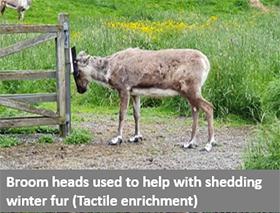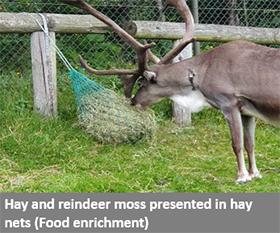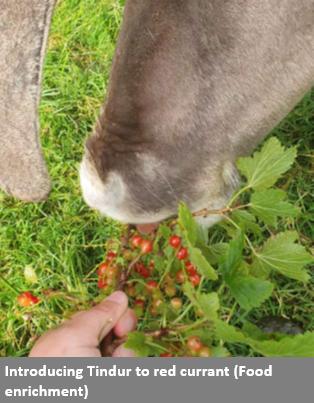Methods
Animals & Location

Four reindeer at the Reykjavík Park & Zoo, in Iceland, were observed from June 2020 until October 2020. This small reindeer herd consists of:
- Regína, female, 12 years old
- Gullbrá, female, 8 years old
- Tindur, male, 8 years old
- Hallveig, female, 5 years old
These reindeer have all year round access to an outdoor enclosure (~5.800 m2), and an indoor enclosure (~100 m2). They have never been exposed to environmental enrichment before, nor have they been trained in any specific way.
Experimental procedure

This study started with a Baseline period, of 10 days, where the reindeer were observed without enrichment. It was then followed by an enrichment period, that lasted for about 4 months.
Ten behaviours were divided into four baseline categories, which were feeding behaviours, locomotory behavours, passive behaviours, and social interactions.These behaviours were recorded during both periods, using a scan sampling method with two-minute intervals.
During the enrichment period, a fifth behaviour category called “Enrichment interaction” was recorded. It contained five new behaviours. And all occurrences of these behaviours were recorded, as well as the duration of each behaviour.
Food enrichment

Twenty different types of novel food and branches were presented to the reindeer.
Novel food:
- Apples (Malus domestica)
- Banana (Musa acuminata)
- Berry mix (Vaccinium myrtillus, Fragaria x ananassa, Rubus idaeus)
- Black currant (Ribes nigrum)
- Cheerios cereal
- Fresh basil (Ocimum basilicum)
- Fresh coriander (Coriandrum sativum)
- Fresh rosemary (Salvia Rosmarinus)
- Lettuce (Lactuca sativa)
- Organic, sugar free peanut butter
- Raisins (dried fruits of Vitis vinifera)
- Red currant (Ribes rubrum)
- Store bought blueberries (Vaccinium myrtillus)
- Store bought mushrooms (Basidiomycota)
- Wild blueberries (Vaccinium myrtillus)
- Wild mushroom (Leccinum scabrum)
Branches:
- Birch (Betula pubescens)
- Cottonwood (Populus trichocarpa)
- Rowan (Sorbus aucuparia)
- Willow (Salix alaxensis)
In addition to presenting novel food, their familiar food was spread throughout the outdoor enclosure in three different ways, instead of presenting it at their familiar feeding station, as enrichment. Their familiar food was presented in banana boxes, hay nets, and treat balls.
Olfactory enrichment
Five different essential oils, and five different spices were chosen for this study.
Each essential oil was applied to a wooden log, alongside a wooden log bearing a near odourless organic solvent (Diethyl phthalate) that was used as a control stimulus.
Essential oils:
- Jasmine (Jasminum officinale)
- Lavender (Lavandula spica)
- Lemon (Citrus limon)
- Peppermint (Mentha × piperita)
- Tea tree (Melaleuca alternifolia)
The spices were mixed with the animals! food, alongside a non-scented food pile, as well as presented separately as a trail on the ground.
Spices:
- Black pepper (Piper nigrum)
- Chili powder (Capsicum annuum)
- Cinnamon (Cinnamomum verum)
- Garlic powder (Allium sativum)
- Oregano (Origanum vulgare)
Tactile enrichment
Four different novel objects were used as tactile enrichment:
- Old branches
- Hard bristled broom brush
- Soft bristled broom brush
- Pine trees
- Yoga ball
The reasons for selecting these novel objects were that they were easily accessible, and they have been used on other animals at the zoo, such as the goats. Studies on cows also showed that broom bristles are attractive to the animal, therefore two types of broom bristles were chosen for the present study.
Responsible for this page:
Director of undergraduate studies Biology
Last updated:
05/27/21
